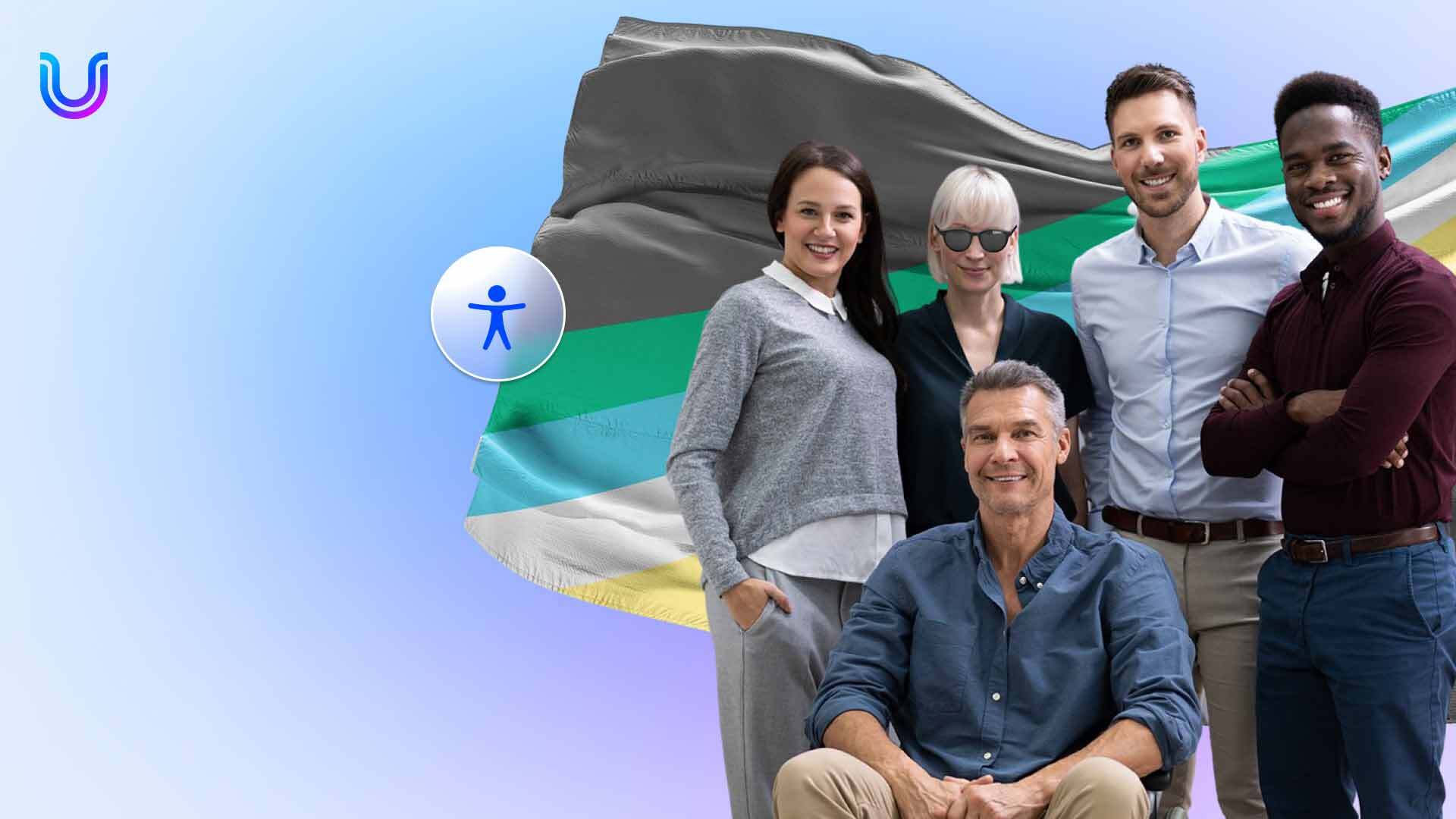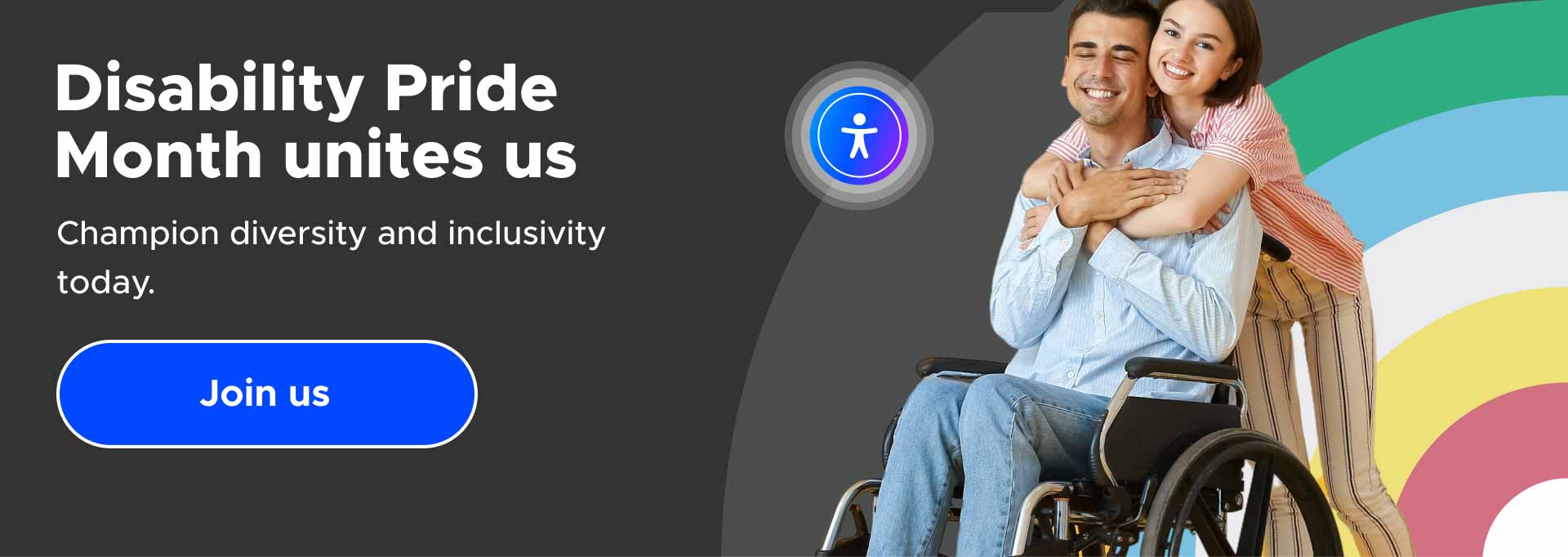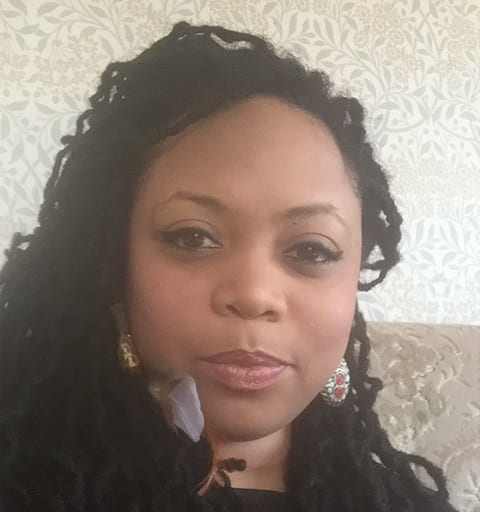Disability pride month: celebrating inclusivity – now & always

July is the official Disability Pride Month in the United States. But we’re here to pay tribute to the community daily by taking a deeper dive into the history of disability pride month. Why does it matter? How can you make a difference in the daily lives of people with disabilities?
Understanding the design and history of the disability pride flag also provides greater community insight into raising awareness for disability inclusion. Let us give you a deeper understanding of how disability pride evolved and how discrimination against the community of people with disabilities affects us all. Last but certainly not least, we’ll discuss how technology supports digital accessibility and makes a difference in the lives of millions worldwide.
What is disability pride awareness month & why it matters?
Over one billion people have disabilities worldwide, representing the most significant global minority and a wide range of generations, races, genders, sexual orientations, religions, and socio-economic backgrounds. Naturally, they seek and deserve to participate equally in society, including through digital experiences.
We all have a social responsibility to better our world and ensure inclusivity. We can all commit to celebrating the diverse backgrounds of people with disabilities and finding common ground. Start by creating fair play and equal grounds everywhere—off and online. That is the essence of Disability Pride Awareness Month.
We start with the story behind the disability pride flag and explain why it’s a meaningful, globally recognized event.
Disability pride month: celebrate a universal cause
People with disabilities have faced social stigmas and judgment for centuries. Logically, the development and establishment of Disability Pride Month closely intertwines with the civil rights movement. Disability Pride Month parallels the ADA’s 33rd anniversary, culminating decades of disability rights advocacy.
Disability Pride recognizes how society treats people with disabilities and other marginalized groups, including women, people from various ethnic and racial backgrounds, and members of the LGBTQ community. Within the disability pride flag, Disability Pride Month events, activities, representation, design, and colors advocate for community integration. And to us, above all, barrier-free digital accessibility for everyone.
The disability pride flag: history & meaning
The disability pride flag’s colors and symbols represent inclusion, similar to the LGBTQ pride flag. The original was designed by Ann Magill, featuring a brightly colored lightning bolt on a black background. After receiving feedback that the original colors could negatively impact people with epilepsy, Magill redesigned it with muted colors, symbolizing the diverse facets of daily life for people with disabilities.
What does the disability pride flag look like today?
- Charcoal gray background: In memory of the victims of ableist abuse and violence, including children or those killed, suicides, or individuals who suffered from negligence
- Diagonal band: Cutting across the barriers blocking people with disabilities from full participation, integration, and inclusion in society
- Red stripe: Physical disabilities (chronic pain/fatigue, mobility impairment, loss of limbs)
- Gold stripe: Neurodivergence (autism, ADHD, dyslexia)
- White stripe: Undiagnosed and invisible disabilities
- Blue stripe: Psychiatric disabilities (depression, PTSD, anxiety, etc.)
- Green stripe: Sensory disabilities (hearing loss, visual impairments, etc.)
The disability pride flag is now publicly available for celebrations and disability pride parades worldwide. As you’ll learn from the insights that follow, disability pride is now on the world stage.
History of disability pride month: now a global phenomenon
The first Disability Pride Parade was in Boston on October 6, 1990. Over 400 people marched, wheeled, or drove to Boston Common, sparking the motivation for people to acknowledge that disability is part of the human experience. While the first disability pride parade was a success, it took a while for communities in other cities to host respective parades.
Chicago has the longest-running series of Disability Pride Parades, starting in 2004. Other major U.S. cities, including Philadelphia, New York, Los Angeles, and Buffalo, have organized at least two Disability Pride Parades since 2012. The movement has also spread across the Atlantic, with Brighton, England, hosting its first event in 2017.
Disability Pride Month is symbolic. People with disabilities are also people with abilities. They’re proactive members of society, working tirelessly to break down all barriers to full inclusion. Fortunately, major U.S. cities will host 2024 celebrations that you can attend.
Notable 2024 Celebrations Will Include:
- Chicago, Illinois: Disability Pride Parade, July 20, 2024
- Harrisburg, Pennsylvania: Disability Pride Day at the Capitol, May 1, 2024
- Long Beach, California: Disability Pride Celebration, July 26, 2024
- Nebraska: Disability Pride Celebration 2024 July 27, 2024
The ADA: impact on disability pride awareness month
Our global population is gaining awareness and celebrating people with disabilities, diverse experiences, and societal integration. The signing of the ADA provided a rallying point for the community to demand full inclusion in society. The ADA outlines provisions for increased accessibility to physical infrastructure and encourages employers to ensure work environments accommodate individuals with disabilities—from wheelchair ramps and unique treatments to service animals.
The civil rights of people with disabilities are also protected within the ADA to prevent discrimination in the workplace and overall.
With the dedication of activists advocating for people with disabilities, a public campaign forefronted critical rights of the community, leading to the establishment and implementation of the ADA and its laws.
The Capital Crawl was a catalytic event on March 12, 1990, uniting roughly 1,000 community members of people with disabilities. They made their way up the stairs of Capitol Hill, crawling or moving with mobility aids they depended on set aside, like wheelchairs, walkers, crutches, and others. It was a clear and dramatic statement demanding that the U.S. Congress pass the ADA, which it did in July of 1990.
More recently, the ADA interpretation includes digital accessibility, a critical element of user experience that ensures the inclusion of anyone engaging with online environments and digital assets.
What is Ableism & why is it important in the history of disability pride month?
Historically, Disability Pride Month celebrates humanity, the community of people with disabilities, and their contribution to society. Ableism, on the other hand, is a systematic means to dehumanize people with disabilities. It’s a movement and thought system creating stigmas that define community members as inferior or less capable than anyone else.
An increasing number of organizations are expanding their labor force to include people with disabilities and impairments. Many companies embrace advocacy for disability rights and DEI (Diversity, Equity, and Inclusion), while other organizations still pass judgment and may not recruit individuals from the community.
Sadly, people often compare ableism to ideologies like nazism or adversity faced by the LGBTQ community. As an ideology, ableism frequently crosses over various forms of oppression, including sexism, racism, homophobia, and more. Using words and language that pass judgment on people with disabilities is a significant part of ableism, from emphatic expressions like “You retard!” to “I’m talking to you; what are you deaf?” These are both extreme but common colloquialisms that intentionally or unintentionally drive ableism.
Being aware of how we speak verbally and with our body language is a critical means to fight ableism and advocate for the inclusion of all people with disabilities.
Honoring disability awareness pride month & the people it celebrates
1. Educate Yourself About Ableism
As discussed, Ableism is a belief system that assumes people with disabilities need fixing. As a result, it devalues and discriminates against this critical population group.
Learn the appropriate terminology: two phrases often describe people in the disability community: disabled people and people with disabilities. So, which one should you use? Always use “people with disabilities” because they’re people first. By contrast, the phrase “disabled people” identifies a person by their disability, which may be considered impolite and demoralizing. In other words, a person isn’t a disability—they have a disability.
Read up on the subject: Disability pride awareness and education aren’t possible without research, and reading books is a crucial way to understand disability pride better. See the recommended reading below.
- “Unbroken: 13 Stories Starring Disabled Teens” (edited by Marieke Nijkamp)
- “Disability Visibility: First-Person Stories From the Twenty-First Century” (edited by Alice Wong)
- “Haben: The Deafblind Woman who Conquered Harvard Law” by Haben Grima
- “Sitting Pretty: The View From My Ordinary Resilient Disabled Body” (by Rebekah Taussig)
- “We Are Never Meeting in Real Life” (by Samantha Irby)
- “The Pretty One” (by Keah Brown)
- “The Silence Between Us” (by Alison Gervais)
2. Embrace & integrate digital accessibility
With the evolution of digital transformation, many assistive technologies are available to help make your website and digital assets inclusive of everyone, most notably people with disabilities. Enhancing digital accessibility can help your company comply with the ADA, WCAG, and all other web accessibility laws. Above all else, this technology enables you to empower people with disabilities with access to an equitable web and digital experience.
3. Participate in Disability Pride Month
What’s the best way to embrace disability? Find the parade or celebration near you and join the fun! Whether you have a disability or not, this is a beautiful opportunity to help create a more inclusive world.
Here are a few notable events that may be near you:
- New York: Disability Unite Festival
- Pennsylvania: Disability Pride PA
- Illinois: Disability Pride Parade
- Missouri: FestAbility: A Celebration of Disabilities
4. Spread the Word on Social Media
Help people with disabilities connect while raising overall awareness. Notable disability pride hashtags include #TheBarriersWeFace, #WheelchairLife, and #ActuallyAutistic.
Disability pride month awareness – every day, not just once a year
Celebrating Disability Pride Month is an annual event, but we should always embrace its message. It’s a blueprint for promoting inclusivity through raised awareness and empathy for our fellow human beings. It implores us to promote physical and digital accessibility for people of all abilities, a principle all businesses and individuals should be proud to support.
UserWay: Disability Pride & Digital Accessibility
At UserWay, disability pride starts with enhancing digital accessibility for people and organizations globally. Our AI-powered assistive technology helps ensure the web is accessible to anyone with diverse needs, especially people with disabilities. Let’s take pride in helping our fellow citizens thrive in the digital world. Learn how working with UserWay can help you achieve this essential goal with its inclusive technology, which engages individuals of all abilities for next-level interactivity, user experience, and barrier-free access.
Common FAQs
What’s the main purpose of disability pride month?
Disability Pride Month is a day that embraces and honors people’s uniqueness by increasing visibility and awareness of the positive pride people with disabilities feel. For people with disabilities, this celebration inspires self-approval and champions every type of disability. In addition to the celebratory day, Disability Pride Month also helps encourage public conversations about disabilities and their related challenges.
When is Disability Pride Month, and how can I promote it year-round?
People celebrate disability pride month every July. It’s an opportunity for everyone to celebrate, raise awareness, and highlight voices during the month. But fostering inclusion and celebrating diversity should be a daily part of our lives. Organizations can look into creating an accommodating environment and digital experience for all employees and stakeholders, but most importantly, respecting our differences as individuals.
People with disabilities can also have exceptional skills, talents, and abilities. Look past the disability and see the person in front of you.
What Are the Origins of Disability Pride Month?
Disability Pride began as a celebration in Boston in 1990, the same year the Americans with Disabilities Act (ADA) became law. Subsequently, it evolved into a month-long celebration culminating in 2015, 25 years after the ADA was signed.





Share